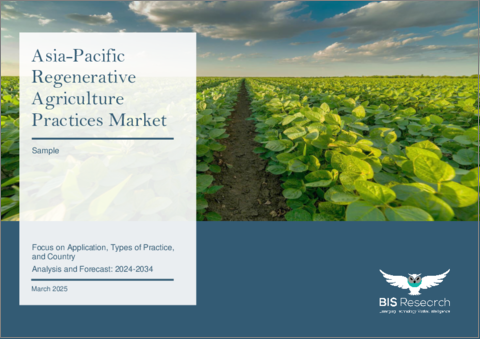|
|
市場調査レポート
商品コード
1676616
アジア太平洋のリジェネラティブ農業(環境再生型農業)市場:用途別、実施タイプ別、国別 - 分析と予測(2024年~2034年)Asia-Pacific Regenerative Agriculture Practices Market: Focus on Application, Types of Practice, and Country - Analysis and Forecast, 2024-2034 |
||||||
カスタマイズ可能
|
|||||||
| アジア太平洋のリジェネラティブ農業(環境再生型農業)市場:用途別、実施タイプ別、国別 - 分析と予測(2024年~2034年) |
|
出版日: 2025年03月12日
発行: BIS Research
ページ情報: 英文 50 Pages
納期: 1~5営業日
|
全表示
- 概要
- 図表
- 目次
アジア太平洋のリジェネラティブ農業(環境再生型農業)の市場規模は、2024年に24億8,840万米ドルとなりました。
同市場は、2034年には63億5,750万米ドルに達し、予測期間の2024年~2034年の間に9.83%の堅調なCAGRを示すと予測されています。持続可能性と土壌の健全性回復への注目の高まりが、アジア太平洋のリジェネラティブ農業市場の成長を促進しています。主な促進要因としては、有機栽培や持続可能な方法で生産された製品に対する消費者の需要の高まりや、環境に優しい農業を支援する政府の取り組みが挙げられます。さらに、この地域の再生農法の採用と効率は、技術の進歩とデータ主導のソリューションによって強化されています。
| 主要市場統計 | |
|---|---|
| 予測期間 | 2024年~2034年 |
| 2024年の評価 | 24億8,840万米ドル |
| 2034年の予測 | 63億5,750万米ドル |
| CAGR | 9.83% |
アジア太平洋のリジェネラティブ農業市場は、気候変動、土壌劣化、持続可能な食糧生産に対する懸念の高まりにより、着実に拡大しています。生物多様性を改善し、土壌の健全性を回復し、炭素排出量を削減する環境に優しい農法を奨励するため、この地域の各国政府は法律を制定し、インセンティブを提供しています。従来の農業に再生技術を取り入れる取り組みは、中国、日本、オーストラリア、インドなどの国々が主導しています。
市場の拡大は、有機栽培や持続可能な方法で調達された食品に対する消費者の意識と需要の高まりによっても加速しています。消費者や企業が持続可能なサプライチェーンをより重視するようになった結果、農業関連企業は変化する環境基準や規制基準を遵守するためにリジェネラティブ農業を採用しています。
この変化は、主に技術開発によってもたらされています。農家は、データ分析、AIによる土壌モニタリング、精密農業を導入することで、生産性を向上させ、資源利用を最適化することができます。被覆作物、輪作、アグロフォレストリー、減耕起、炭素隔離技術などは、アジア太平洋で普及しつつある主なリジェネラティブ農業手法の一部です。
アジア太平洋のリジェネラティブ農業市場は、政府、民間セクターの投資、消費者の関心の高まりの助けを借りて大きく成長し、この地域全体でより弾力的で持続可能な農業セクターを作るのに役立つと期待されています。
当レポートでは、アジア太平洋のリジェネラティブ農業(環境再生型農業)市場について調査し、市場の概要とともに、用途別、実施タイプ別、国別の動向、および市場に参入する企業のプロファイルなどを提供しています。
目次
エグゼクティブサマリー
第1章 市場:業界の展望
- 動向:現在および将来の影響評価
- 研究開発レビュー
- ステークホルダー分析
- 市場力学の概要
- スタートアップ資金調達のサマリー
- 再生型農業の実践導入状況
第2章 地域
- 地域別概要
- アジア太平洋
第3章 市場-競合ベンチマーキングと企業プロファイル
- 地理的評価
- 企業プロファイル
- 会計ツールプロバイダー
- Cropin Technology Solutions Private Limited
第4章 調査手法
List of Figures
- Figure 1: Asia-Pacific Regenerative Agriculture Market (by Application), $Million, 2024, 2027, 2034
- Figure 2: Asia-Pacific Regenerative Agriculture Market (by Practice), $Million, 2024, 2027, 2034
- Figure 3: Key Events
- Figure 4: Sale of Organic Foods, $Billion, 2018-2022
- Figure 5: Average Price Per Carbon Credit, $/ton, 2021-2022
- Figure 6: Patent Filed (by Country), January 2021-August 2024
- Figure 7: Patent Filed (by Company), January 2021-August 2024
- Figure 8: Impact Analysis of Asia-Pacific Regenerative Agriculture Practices Market Navigating Factors, 2024-2034
- Figure 9: China Regenerative Agriculture Practices Market, $Million, 2023-2034
- Figure 10: Japan Regenerative Agriculture Practices Market, $Million, 2023-2034
- Figure 11: India Regenerative Agriculture Practices Market, $Million, 2023-2034
- Figure 12: Australia Regenerative Agriculture Practices Market, $Million, 2023-2034
- Figure 13: Rest-of-Asia-Pacific Regenerative Agriculture Practices Market, $Million, 2023-2034
- Figure 14: Strategic Initiatives, 2021-2024
- Figure 15: Share of Strategic Initiatives, 2021-2024
- Figure 16: Data Triangulation
- Figure 17: Top-Down and Bottom-Up Approach
- Figure 18: Assumptions and Limitations
List of Tables
- Table 1: Market Snapshot
- Table 2: Opportunities
- Table 3: Regenerative Agriculture Practices Market (by Region), $Million, 2023-2034
- Table 4: Asia-Pacific Regenerative Agriculture Practices Market (by Application), $Million, 2023-2034
- Table 5: Asia-Pacific Regenerative Agriculture Practices Market (by Practice), $Million, 2023-2034
- Table 6: China Regenerative Agriculture Practices Market (by Application), $Million, 2023-2034
- Table 7: China Regenerative Agriculture Practices Market (by Practice), $Million, 2023-2034
- Table 8: Japan Regenerative Agriculture Practices Market (by Application), $Million, 2023-2034
- Table 9: Japan Regenerative Agriculture Practices Market (by Practice), $Million, 2023-2034
- Table 10: India Regenerative Agriculture Practices Market (by Application), $Million, 2023-2034
- Table 11: India Regenerative Agriculture Practices Market (by Practice), $Million, 2023-2034
- Table 12: Australia Regenerative Agriculture Practices Market (by Application), $Million, 2023-2034
- Table 13: Australia Regenerative Agriculture Practices Market (by Practice), $Million, 2023-2034
- Table 14: Rest-of-Asia-Pacific Regenerative Agriculture Practices Market (by Application), $Million, 2023-2034
- Table 15: Rest-of-Asia-Pacific Regenerative Agriculture Practices Market (by Practice), $Million, 2023-2034
Introduction to Asia-Pacific Regenerative Agriculture Practices Market
The Asia-Pacific regenerative agriculture practices market, valued at $2,488.4 million in 2024, is expected to reach $6,357.5 million by 2034, exhibiting a robust CAGR of 9.83% during the forecast period 2024-2034. The increasing focus on sustainability and soil health restoration is driving growth in the APAC regenerative agriculture market. Key drivers include growing consumer demand for organic and sustainably sourced products and government initiatives supporting eco-friendly farming. Additionally, the region's adoption and efficiency of regenerative farming practices are being enhanced by technological advancements and data-driven solutions.
Market Introduction
| KEY MARKET STATISTICS | |
|---|---|
| Forecast Period | 2024 - 2034 |
| 2024 Evaluation | $2,488.4 Million |
| 2034 Forecast | $6,357.5 Million |
| CAGR | 9.83% |
The market for regenerative agriculture in Asia Pacific is expanding steadily due to growing concerns about climate change, soil degradation, and sustainable food production. To encourage environmentally friendly farming methods that improve biodiversity, restore soil health, and lower carbon emissions, governments throughout the region are enacting laws and offering incentives. Initiatives to incorporate regenerative techniques into conventional agriculture are being spearheaded by nations like China, Japan, Australia, and India.
Market expansion is also being accelerated by growing consumer awareness and demand for food that is organic and sustainably sourced. Agribusinesses are adopting regenerative farming to comply with changing environmental and regulatory standards as a result of consumers and businesses placing a higher priority on sustainable supply chains.
This change is largely being driven by technological developments. Farmers can increase productivity and optimise resource use by implementing data analytics, AI-driven soil monitoring, and precision agriculture. Cover crops, crop rotation, agroforestry, reduced tillage, and carbon sequestration techniques are some of the major regenerative practices that are becoming more popular in APAC.
The APAC regenerative agriculture market is expected to grow significantly with the help of the government, private sector investment, and rising consumer interest, helping to create a more resilient and sustainable agricultural sector throughout the region.
Market Segmentation
Segmentation 1: Application
- Crop Production
- Livestock Grazing
- Forestry
Segmentation 2: by Practice
- Soil Health Management
- Water Management
- Biodiversity Enhancement
- Nutrient Management
- Livestock Grazing Management
Segmentation 3: by Country
- China
- Japan
- Australia
- India
- Rest-of-Asia-Pacific
How can this report add value to an organization?
Practice/Innovation Strategy: The practice segment helps the reader understand the specific techniques and methodologies employed in regenerative agriculture, such as soil health management, water management, and biodiversity enhancement. It also provides insight into how these practices contribute to creating sustainable and resilient agricultural systems. Additionally, the study offers a detailed overview of the current state of various regenerative agriculture projects developed by companies and non-profit organizations.
Growth/Marketing Strategy: The APAC regenerative agriculture practices market has seen major development by key participants operating in the market, such as business expansion, partnership, collaboration, and joint venture. The favored strategies of the companies have been partnership, collaboration, and joint venture activities to strengthen their position in the APAC regenerative agriculture practices market.
Competitive Strategy: Key players in the APAC regenerative agriculture practices market analyzed and profiled in the study include project developers and accounting tool providers. The analysis covers market segments by distinct practices, applications served, regional presence, and the impact of key market strategies. Additionally, detailed competitive benchmarking has been conducted to illustrate how players compare, providing a clear view of the market landscape. The study also examines comprehensive competitive strategies, such as partnerships, agreements, and collaborations, to help identify untapped revenue opportunities in the regenerative agriculture practices market.
Table of Contents
Executive Summary
Scope and Definition
1 Market: Industry Outlook
- 1.1 Trends: Current and Future Impact Assessment
- 1.1.1 Increasing Consumer Demand for Organic Foods
- 1.1.2 Rising Carbon Credit Prices
- 1.2 Research and Development Review
- 1.2.1 Patent Filing Trend (by Country and Company)
- 1.3 Stakeholder Analysis
- 1.4 Market Dynamics Overview
- 1.4.1 Market Drivers
- 1.4.1.1 Increasing Corporate Sustainability Goals
- 1.4.1.2 Rising Soil Health Degradation
- 1.4.2 Market Challenges
- 1.4.2.1 High Upfront Costs for Farmers
- 1.4.2.2 Lack of Standardized Measurement and Certification
- 1.4.3 Market Opportunities
- 1.4.3.1 Technological Advancements in Monitoring and Data Analytics
- 1.4.3.2 Expansion of Carbon Markets
- 1.4.1 Market Drivers
- 1.5 Startup Funding Summary
- 1.6 State of Regenerative Agriculture Practice Adoption
- 1.6.1 Agri-food Companies Commitment to Regenerative Agriculture Factors
2 Region
- 2.1 Regional Summary
- 2.2 Asia-Pacific
- 2.2.1 Regional Overview
- 2.2.2 Driving Factors for Market Growth
- 2.2.3 Factors Challenging the Market
- 2.2.3.1 Application
- 2.2.3.2 Practice
- 2.2.4 China
- 2.2.4.1 Application
- 2.2.4.2 Practice
- 2.2.5 Japan
- 2.2.5.1 Application
- 2.2.5.2 Practice
- 2.2.6 India
- 2.2.6.1 Application
- 2.2.6.2 Practice
- 2.2.7 Australia
- 2.2.7.1 Application
- 2.2.7.2 Practice
- 2.2.8 Rest-of-Asia-Pacific
- 2.2.8.1 Application
- 2.2.8.2 Practice
3 Markets - Competitive Benchmarking & Company Profiles
- 3.1 Geographic Assessment
- 3.2 Company Profiles
- 3.3 Accounting Tool Providers
- 3.3.1 Cropin Technology Solutions Private Limited
- 3.3.1.1 Overview
- 3.3.1.2 Top Products/Product Portfolio
- 3.3.1.3 Top Competitors
- 3.3.1.4 Target Customers
- 3.3.1.5 Key Personnel
- 3.3.1.6 Analyst View
- 3.3.1 Cropin Technology Solutions Private Limited
4 Research Methodology
- 4.1 Data Sources
- 4.1.1 Primary Data Sources
- 4.1.2 Secondary Data Sources
- 4.1.3 Data Triangulation
- 4.2 Market Estimation and Forecast






